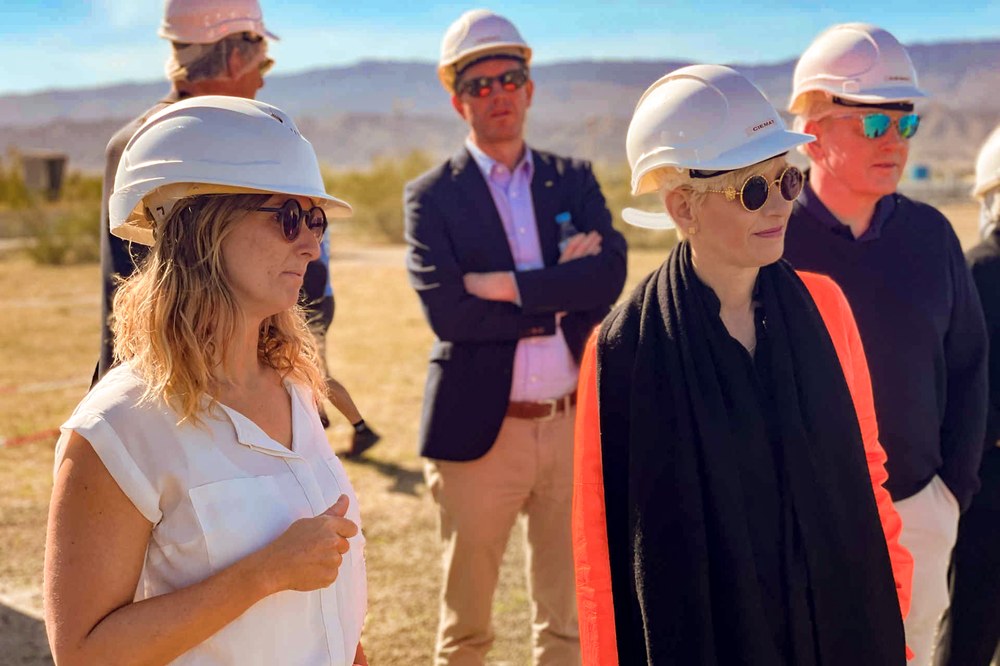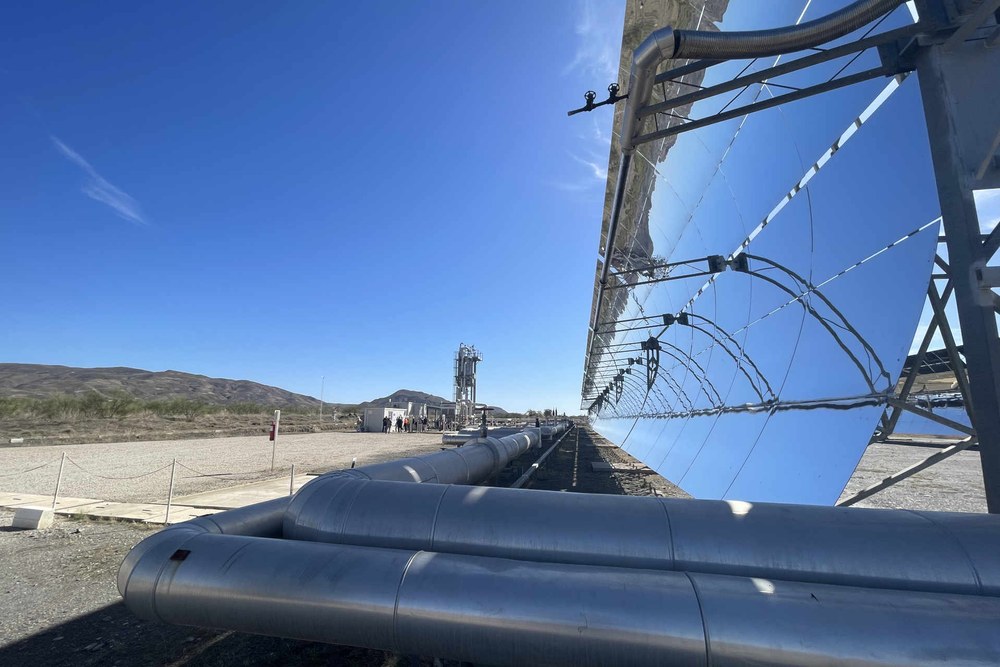Visit highlights ongoing DLR research and industrial solar thermal power plant technologies



- DLR Executive Board visits solar thermal test facilities in Spain.
- DLR energy research has long cooperated with research institutions and universities in Spain and Portugal.
- New technologies are tested and further developed under real conditions in these typically sunny regions.
- Focus: Energy research, solar thermal power plant technologies
The Chair of the Executive Board of the German Aerospace Center (Deutsches Zentrum für Luft- und Raumfahrt; DLR), Anke Kaysser-Pyzalla, visited various test facilities on the Iberian Peninsula from 28 to 31 March 2023, where DLR is participating in research into new technologies for lower-cost solar power. Specifically, she will visit the largest European test facility for solar thermal technologies, the Plataforma Solar de Almería in Spain, as well as the Andasol and Gemasolar solar thermal power plants and the Évora Molten Salt Platform parabolic trough test facility in Portugal. These sites demonstrate the path from research to application, to which DLR has contributed significantly with its involvement in technology development for solar thermal power plants.
"DLR's research together with our industrial partners at CIEMAT's Plataforma Solar de Almería has played and continues to play a major role in the successful development of commercial solar thermal power plant technology. In Spain, solar power plants with thermal storage have now contributed to energy supply security for more than fifteen years," emphasised Kaysser-Pyzalla during her visit. "Since 2021, research at the solar thermal parabolic trough test facility in Évora, Portugal, has been providing new findings. Together with our partners in Spain and Portugal, we are committed to bringing solar thermal power plant technologies into widespread use even more efficiently and cost-effectively in the future."
Almería – European hub for solar power plant technologies
The Plataforma Solar de Almería (PSA) had a key role in the European market launch of solar thermal power plants, especially in Spain. Many of the innovations for these new power plants were developed and tested at the PSA. Initial research work began as early as 1981 with the trial operation of the European test centre under the project management of DLR. Researchers from the DLR Institute of Solar Research are still working on the PSA today as part of a cooperation agreement with the 'Centro de Investigaciones Energéticas, Medioambientales y Tecnológicas' (CIEMAT) research centre. Various test facilities are available there, which are further developed or newly constructed according to market requirements and the needs of industrial partners.
Current DLR research projects in Almería are concerned with the quality testing of components, with meteorological measurements for solar power plants, especially with regard to the influence of desert conditions, and with the solar thermal generation of hydrogen. Two spin-offs, CSP Services GmbH and Volateq GmbH, have emerged from the DLR team in Almería. They market optical and thermal measurement technologies developed at DLR and continue to further refine them. Today, almost all solar thermal power plants use the Eurotrough parabolic trough collector, which was developed in a European joint project with the participation of DLR in Almería.
Andasol – Europe's first commercial solar power plant
The parabolic trough power plant Andasol 1 became Europe's first solar thermal power plant when it went into operation in 2008. Andasol 2 followed in 2009, and Andasol 3 in 2011. The solar power plant complex, located to the north of the Sierra Nevada in the Spanish province of Granada, is the largest in Europe to date.
DLR researchers were involved in the development of the collector (Eurotrough) as well as in the search for a site, the construction and the commissioning of the Andasol 3 power plant. Since then, DLR has been supporting the power plant in the development of measurement systems and data evaluation. DLR is currently working with the DLR spin-off Volateq. The company specialises in using digital twins to analyse measurement data and images of the mirror fields of solar thermal power plants and photovoltaic systems acquired using drones.
Andasol 3 is owned by the Spanish company Marquesado Solar S.L., in which Stadtwerke München GmbH, RWE Innogy GmbH and RheinEnergie AG hold direct stakes as the main shareholders. The solar field of Andasol 3 measures 500,000 square metres and consists of 210,000 parabolic mirrors and 22,000 absorber pipes. Approximately 29,000 tonnes of salt serve as the thermal storage medium. The average annual operating time is around 3700 hours, during which approximately 165 gigawatt hours of electricity are generated.
Gemasolar – first solar tower power plant with thermal storage
The Gemasolar solar thermal power plant is the world's first solar tower power plant with a connected thermal storage tank. Using stored heat, it can produce electricity for 15 hours without any available solar radiation.
Over an area of 195 hectares, 2650 heliostats stand in concentric circles around the central solar tower, which is 140 metres tall. Each of the mirrors has a surface area of 120 square metres and reflects incident sunlight to the radiation receiver at the top of the solar tower. There, the concentrated sunlight heats salt to up to 500 degrees Celsius. The hot salt is passed on to a heat exchanger, which heats water in a steam generator. The resulting steam drives a turbine to generate electricity.
Gemasolar delivers up to 80 gigawatt hours of electricity per year with a capacity of approximately 20 megawatts and an annual operating time of up to 6450 hours. The plant has been in operation since May 2011 and has belonged to the European energy company Q-Energy since 2020.
Évora – research for innovations in solar thermal power plants
In Évora, Portugal, DLR and the University of Évora have been operating a solar thermal test facility – the Évora Molten Salt Platform (EMSP) – since October 2021. Various experimental setups here enable the testing of molten salt as a heat transfer medium in solar power plants, ranging from important solar field components to control concepts for solar power plants. The facility is owned by the University of Évora.
The EMSP solar field has a total output of 3.5 megawatts. Its four parabolic trough collectors are connected in series to form what is referred to as a collector loop, the smallest basic element of a commercial plant. To transfer the technology to a commercial power plant, 50 to 100 such collector loops could be combined.
In 2021, researchers from DLR and the University of Évora filled the plant with 90 tonnes of salt from the industrial partner Yara and then operated it for over 5000 hours at temperatures of up to 500 degrees Celsius. Commissioning is currently underway with a different salt mixture at temperatures of up to 565 degrees Celsius. In addition, the world’s first operation of the ‘HelioTrough® 2.0’ parabolic trough collectors from project partner TSK Flagsol Engineering GmbH with Solar Salt was successfully completed in March 2023. These troughs are characterised in particular by a collector length that is one third greater, a higher concentration factor and improved tracking accuracy.
In future, DLR and the University of Évora want to test further innovations for solar thermal power plants together with industry. These include, for example, the hybridisation of solar thermal power plants with photovoltaic systems, power-to-heat concepts and a comprehensive digitalisation of the technology.
